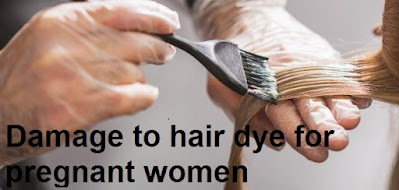 |
Damage to hair dye for pregnant women |
Hair dye
Women resort to dyeing their hair to change its color or to hide the white hair that results from aging. Hair dyes consist of chemicals with different concentrations, and there are several types of hair dyes; Temporary hair dye
The type that does not penetrate the hair shaft, and disappears after washing the hair once or twice, and the second type is a semi-permanent dye that penetrates the hair shaft and almost disappears after washing the hair five to ten times. The last is permanent (oxidative) hair dye, which is the most famous type that women usually use, as the dye penetrates the hair shaft and causes a permanent change in it, and the color remains until the hair falls out and is replaced by a new one, and it is worth noting that The darker the color of the dye, the more coloring chemicals it contains.
Damage to hair dye for pregnant women
Research based on studying hair dye damage during pregnancy is still limited, but some studies have shown that there is a relationship between the use of hair dyes during pregnancy or a month before conception and an increase in the incidence of neuroblastoma in children,[2] while studies have shown Another is that the woman’s body absorbs a very small amount of chemicals found in hair dyes,
and this percentage does not pose a threat to the fetus, and the percentage that poses a danger to the fetus is much greater than that found in hair dyes, but many doctors advise pregnant women to avoid dyeing their hair During pregnancy, especially in the first trimester, it is recommended to replace chemical hair dyes with henna, as this is safer for the health of the fetus.
Tips for dyeing hair during pregnancy
Many specialists advise postponing hair dye after childbirth due to the absence of sufficient evidence and studies on this subject as we mentioned, but if a woman insists on dyeing her hair during pregnancy, she should follow the following advice
· Follow the instructions included with the hair dye.
· Wear special gloves while mixing the dye and applying it to the
hair.
· Dye hair in a well-ventilated room.
· Wash the hair and rinse the scalp well after completing the hair dye
process.
· Trying to dye hair strands without reaching the scalp, because the
dyeis absorbed if it reaches the scalp, not the hair itself.
· Do not mix different types of hair dye products with each other.
Henna as an alternative to dye during pregnancy
Henna can be used as an alternative to the dye during pregnancy, but there are some tips that women should follow when using henna, including the following:
· Ensure that the type of henna used is safe for the fetus; There are
many types of henna.
· The use of pure natural henna, whose effect often remains for
a period of one to four weeks, and it should be noted that black henna cannot benatural, so it is worth avoiding its use.
· Do an allergy test before the hair dye process to ensure that you are
notallergic to the product.
· Avoid using henna that contains para-phenylenediamine (PPD),
which can cause a serious allergic reaction to the skin in some, and the allergic reaction may last for months and is often difficult to diagnose and treat, and it is worth noting that black henna contains:this matter.
· Read the ingredients of henna or dye before using it, to make sure
that all its ingredients are safe and that the woman is not allergic to any compound present in it, and not to use henna of unknowningredients and source.
Using hair dye while breastfeeding
There is insufficient evidence on the extent of the effect of hair dye on breast milk and thus on the infant, but because the amount that is absorbed and reaches the blood is small, the possibility of harm to the infant is small, and it should be noted that no cases of damage were recorded as a result of the use of hair dye during breastfeeding, However, studies are still being conducted to give definitive results on this subject
The effects of hair dye on women in general
Some studies have shown that there is a relationship between the use of hair dyes and the incidence of some types of cancer, while other studies have proven that there is no relationship between the use of hair dyes and cancers. that it
In general, it is recommended to reduce the use of hair dyes, or to start using them only with the onset of white hair, or to use natural alternatives to dyeing hair, with emphasis on the importance of following the instructions attached with packages of hair dyes, and it is worth noting that the work of the patch test ) Before using any dye is necessary, and the test is done by placing a small amount of hair dye behind the ear or in the inner part of the elbow, then waiting until the dye dries, if signs of sensitivity appear or the woman feels uncomfortable, the dye should not be used, In order to avoid the occurrence of contact dermatitis, contact dermatitis,or an allergic reaction
